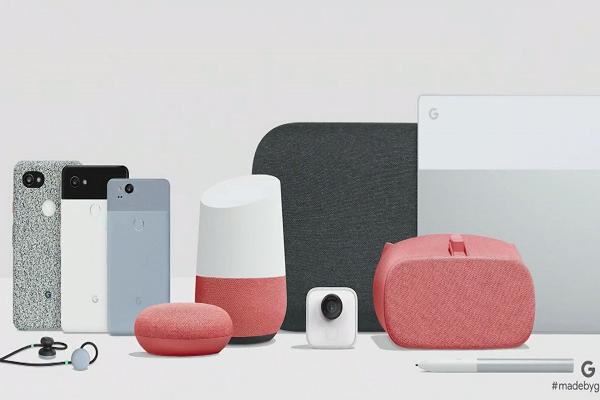Yesterday, Google released eight devices that all screamed a single message – Google’s hardware ambitions are both serious and AI-centric. Google is doubling down on hardware, as a means to democratize the use of AI. The company has recently poured resources into hardware development, and while hardware will always be a fraction of their advertising and cloud businesses, these products will be key factors in Google’s future as a competitor with Apple, Samsung, and Amazon.
Last year, Google charged former Motorola president Rick Osterloh with unifying the new hardware division, and more recently, the company paid $1.1 billion to acquire over 2,000 smartphone engineers and some valuable IP from HTC (although their efforts won’t be reflected in this product line). Now all-in on hardware, the question becomes one of marketing, manufacturing, and distribution power that will determine if they can elbow a position among some of the world’s largest and most successful consumer product companies.

They keynote was heavy on Google’s “AI first” message, but now that sentiment seemed to take on a more tangible form as each presenter explained how the hardware products will facilitate AI first computing. In 2017 Sundar has opened each of his public remarks stating Google’s goal of becoming and AI first company. This has obvious implications for Google’s advertising, Maps, YouTube, and cloud business, but we are adding hardware to this list.
We are most excited to see how well Google has woven their AI Assistant into the fabric of the device ecosystem. This is important because integrating an array of devices (i.e. the handoff between the home and the road) is what will push us toward the next generation of our interaction with machines. Don’t mistake Amazon’s early lead in smart speaker market share for a lead in the AI first world. While Google is lightyears behind Alexa’s install base, we believe Google has the best AI (see our comparison here), and their more robust product line could catch up quickly.

In an AI first world (as opposed to mobile first), Sundar explains, computers will adapt to the humans that use them, instead of the other way around. 4 things They must be conversational and sensory, ambient and multi-device, thoughtfully contextual, and they must learn and adapt. How is Google’s hardware collection enabling the AI first transition?
Google’s stepped-up efforts in hardware will have little impact on the broader smartphone market share. We estimate in the U.S. today that Pixel accounts for about 1% of the market, iPhone for 50%, and Samsung for 30%. We believe this increased effort around the Pixel 2 could inch up market share from 1% to 2-3% in the U.S., likely at the cost of other Android devices. As for the smart speaker market, Google’s efforts in the next few years could yield a measurable increase in market share. Today, we estimate various forms of Alexa account for roughly 70-80% and we envision Google’s smart speaker share increasing from about 25% today to greater than 35% in the next 3-5 years.
Pixel 2 and Pixel 2 XL. As smartphones more or less reach parity on technical specs, the Pixel rises above the noise with pure utilitarianism. The phone may not be as aesthetically pleasing as the iPhone X or other competitors, but it is simply built to work around you. It’s most compelling feature is the pervasiveness of Assistant that can be summoned by squeezing the phone’s sides.
![]()
Google Home Mini and Max. Both of these devices are answers to the Echo Dot and the HomePod (diversifying on size and sound quality are table steaks now), with the aim is to bring the Assistant to as many homes as possible. The Max ($400) appeals to higher-budget audiophiles, and the Mini ($50) is positioned as an impulse buy. Google sweetened the purchase of a Pixel 2 by offering a Mini for free. One of the Pixel 2’s strengths is its integration with Google Home, giving an ambient presence to Assistant.
Google Clips. Clips is a wearable camera for capturing candid memories. This $250 product is a head scratcher and fit’s better in Facebook’s product roadmap.
Pixel Buds. Google is not kidding about making Assistant a ubiquitous presence. Their answer to AirPods are yet another way to stay connected to Assistant. On the positive side, we liked the real-time language translation. On the negative side the design of the buds seem clumsy given they’re connected by a rope-like cable.
Other product announcements. Google also announced a new Pixelbook, an upgraded Daydream VR headset, and plenty of new software features.
Disclaimer: We actively write about the themes in which we invest: artificial intelligence, robotics, virtual reality, and augmented reality. From time to time, we will write about companies that are in our portfolio. Content on this site including opinions on specific themes in technology, market estimates, and estimates and commentary regarding publicly traded or private companies is not intended for use in making investment decisions. We hold no obligation to update any of our projections. We express no warranties about any estimates or opinions we make.